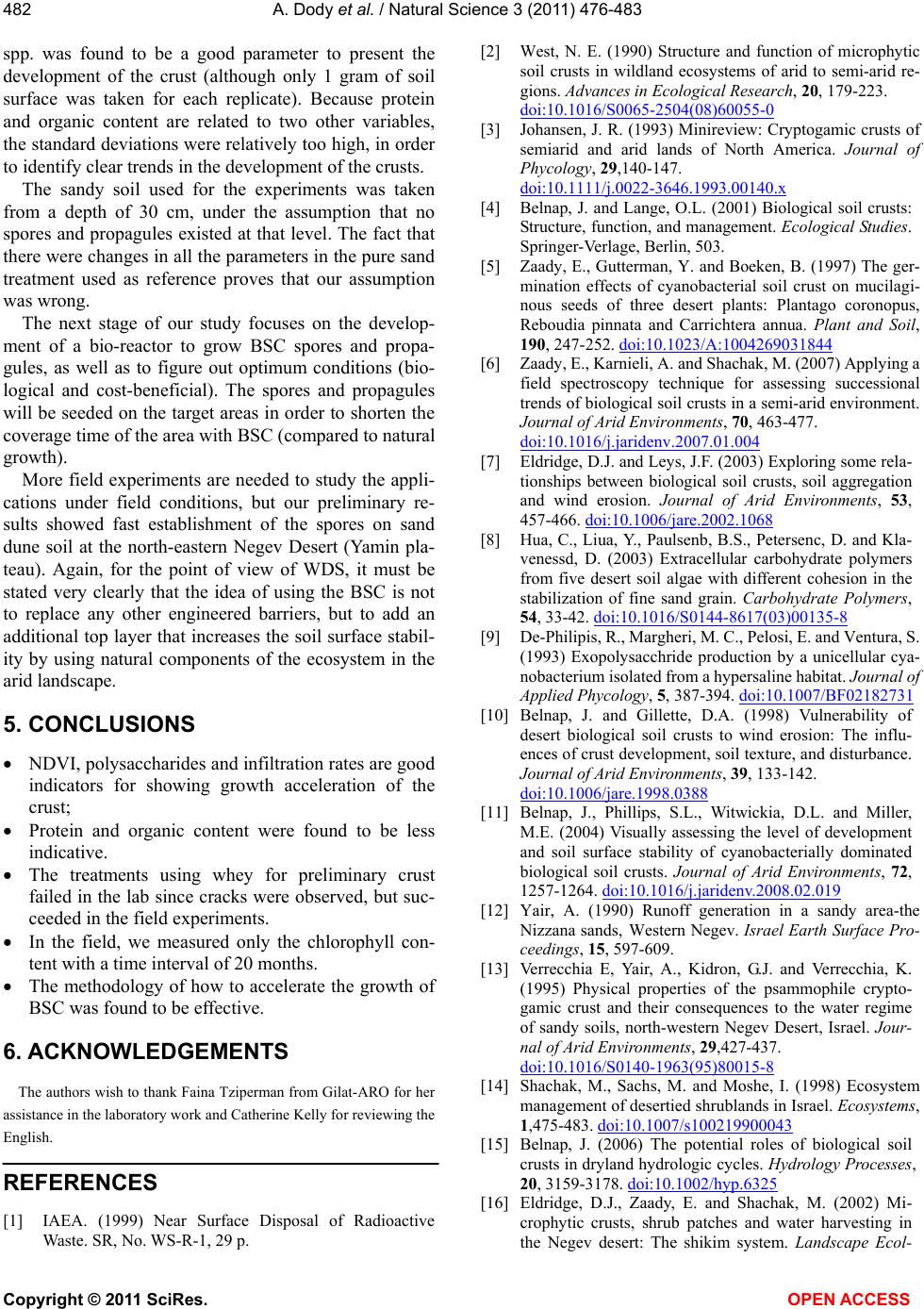
A. Dody et al. / Natural Science 3 (2011) 476-483
Copyright © 2011 SciRes. OPEN ACCESS
482
spp. was found to be a good parameter to present the
development of the crust (although only 1 gram of soil
surface was taken for each replicate). Because protein
and organic content are related to two other variables,
the standard deviations were relatively too high, in order
to identify clear trends in the development of the crusts.
The sandy soil used for the experiments was taken
from a depth of 30 cm, under the assumption that no
spores and propagules existed at that level. The fact that
there were changes in all the parameters in the pure sand
treatment used as reference proves that our assumption
was wrong.
The next stage of our study focuses on the develop-
ment of a bio-reactor to grow BSC spores and propa-
gules, as well as to figure out optimum conditions (bio-
logical and cost-beneficial). The spores and propagules
will be seeded on the target areas in order to shorten the
coverage time of the area with BSC (compared to natural
growth).
More field experiments are needed to study the appli-
cations under field conditions, but our preliminary re-
sults showed fast establishment of the spores on sand
dune soil at the north-eastern Negev Desert (Yamin pla-
teau). Again, for the point of view of WDS, it must be
stated very clearly that the idea of using the BSC is not
to replace any other engineered barriers, but to add an
additional top layer that increases the soil surface stabil-
ity by using natural components of the ecosystem in the
arid landscape.
5. CONCLUSIONS
NDVI, polysaccharides and infiltration rates are good
indicators for showing growth acceleration of the
crust;
Protein and organic content were found to be less
indicative.
The treatments using whey for preliminary crust
failed in the lab since cracks were observed, but suc-
ceeded in the field experiments.
In the field, we measured only the chlorophyll con-
tent with a time interval of 20 months.
The methodology of how to accelerate the growth of
BSC was found to be effective.
6. ACKNOWLEDGEMENTS
The authors wish to thank Faina Tziperman from Gilat-ARO for her
assistance in the laboratory work and Catherine Kelly for reviewing the
English.
REFERENCES
[1] IAEA. (1999) Near Surface Disposal of Radioactive
Waste. SR, No. WS-R-1, 29 p.
[2] West, N. E. (1990) Structure and function of microphytic
soil crusts in wildland ecosystems of arid to semi-arid re-
gions. Advances in Ecological Research, 20, 179-223.
doi:10.1016/S0065-2504(08)60055-0
[3] Johansen, J. R. (1993) Minireview: Cryptogamic crusts of
semiarid and arid lands of North America. Journal of
Phycology, 29,140-147.
doi:10.1111/j.0022-3646.1993.00140.x
[4] Belnap, J. and Lange, O.L. (2001) Biological soil crusts:
Structure, function, and management. Ecological Studies.
Springer-Verlage, Berlin, 503.
[5] Zaady, E., Gutterman, Y. and Boeken, B. (1997) The ger-
mination effects of cyanobacterial soil crust on mucilagi-
nous seeds of three desert plants: Plantago coronopus,
Reboudia pinnata and Carrichtera annua. Plant and Soil,
190, 247-252. doi:10.1023/A:1004269031844
[6] Zaady, E., Karnieli, A. and Shachak, M. (2007) Applying a
field spectroscopy technique for assessing successional
trends of biological soil crusts in a semi-arid environment.
Journal of Arid Environments, 70, 463-477.
doi:10.1016/j.jaridenv.2007.01.004
[7] Eldridge, D.J. and Leys, J.F. (2003) Exploring some rela-
tionships between biological soil crusts, soil aggregation
and wind erosion. Journal of Arid Environments, 53,
457-466. doi:10.1006/jare.2002.1068
[8] Hua, C., Liua, Y., Paulsenb, B.S., Petersenc, D. and Kla-
venessd, D. (2003) Extracellular carbohydrate polymers
from five desert soil algae with different cohesion in the
stabilization of fine sand grain. Carbohydrate Polymers,
54, 33-42. doi:10.1016/S0144-8617(03)00135-8
[9] De-Philipis, R., Margheri, M. C., Pelosi, E. and Ventura, S.
(1993) Exopolysacchride production by a unicellular cya-
nobacterium isolated from a hypersaline habitat. Journal of
Applied Phycology, 5, 387-394. doi:10.1007/BF02182731
[10] Belnap, J. and Gillette, D.A. (1998) Vulnerability of
desert biological soil crusts to wind erosion: The influ-
ences of crust development, soil texture, and disturbance.
Journal of Arid Environments, 39, 133-142.
doi:10.1006/jare.1998.0388
[11] Belnap, J., Phillips, S.L., Witwickia, D.L. and Miller,
M.E. (2004) Visually assessing the level of development
and soil surface stability of cyanobacterially dominated
biological soil crusts. Journal of Arid Environments, 72,
1257-1264. doi:10.1016/j.jaridenv.2008.02.019
[12] Yair, A. (1990) Runoff generation in a sandy area-the
Nizzana sands, Western Negev. Israel Earth Surface Pro-
ceedings, 15, 597-609.
[13] Verrecchia E, Yair, A., Kidron, G.J. and Verrecchia, K.
(1995) Physical properties of the psammophile crypto-
gamic crust and their consequences to the water regime
of sandy soils, north-western Negev Desert, Israel. Jour-
nal of Arid Environments, 29,427-437.
doi:10.1016/S0140-1963(95)80015-8
[14] Shachak, M., Sachs, M. and Moshe, I. (1998) Ecosystem
management of desertied shrublands in Israel. Ecosystems,
1,475-483. doi:10.1007/s100219900043
[15] Belnap, J. (2006) The potential roles of biological soil
crusts in dryland hydrologic cycles. Hydrology Processes,
20, 3159-3178. doi:10.1002/hyp.6325
[16] Eldridge, D.J., Zaady, E. and Shachak, M. (2002) Mi-
crophytic crusts, shrub patches and water harvesting in
the Negev desert: The shikim system. Landscape Ecol-